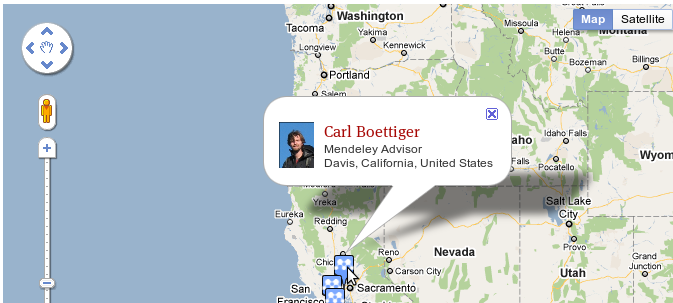A day of Writing
Reviewed Chris’s manuscript.
Completed my revisions to phylogenetics mansucript, meeting with Peter tomorrow to discuss. Still need to work through the discussions of model adequacy Goldman, 1993, Cox’s delta (1961/62), and going beyond (simulations by under both null and test distributions).
Meanwhile, a few thoughts:
Reproducible Research
Mentioned in Thursday’s entry coming across Victoria Stodden’s post on Reproducible research standards such as practiced by Journal of Biostatistics. So I was quite excited to see the slides and audiofrom this year’s AAAS meeting Symposium on reproducible research. I found the presentation of David Donoho, Stanford University; Matan Gavish particularly visionary as a simple yet powerful idea: URIs for all computational objects. They have a working pilot of “verifiable computational research“ scheme which is worth checking out. I’m tempted to start subscribing to UC3 EZID’s DOI system and start tagging my computational objects already. They discuss integration of this system with LaTeX and common computing languages.
I would love to figure out a simple and potentially platform independent way to integrate this into my notebook workflow, tracking my computational objects with a common identifier. It’s something I’ve already wanted to do on a basic level, for instance be able to track back the various locations I’ve embedded a flickr image of a computational result, and have that result link directly to the code that created it. So far I can mimic this with my flickr images including the git commit versions in the description, but it’s not nearly as nice and smooth as a common device identifier that could track the code, the images, the notebook entries in semantic, computer readable manner.
Thoughts on Mendeley Groups
Hit the cap on Mendeley group size (20) for my phylogenetics comparative methods group. Have to decide whether to make it an Open group, where members join without request, group size is not capped, but members cannot access pdfs directly. While my Future of Science (89 members, 51 followers) is a Public Open group, I’ve made my research-area groups Public Invite only groups. The permissions associated with the types can be a bit difficult to keep straight, so I took a moment to jot them down here:
Public Open group: Members can edit meta-data, followers can only see the meta-data. Everyone can comment in the group forum.
Public Invite-only group: Members (limited to 20) can view/edit pdfs. Followers can only see metadata. Everyone can comment in group forum.
Private group: Members can view/edit pdf.
Most of these groups have been joined only by those I invite or already know, but I have received numerous requests from various users to join the groups. It probably would have made the most sense to encourage them to follow these groups, but that works against the goal of an open group fostering community discussion around the topic.
On top of this are my personal categories. I try to keep these in one-to-one correspondence with my groups. Before this year, categories just had the option of public feeds. While the new groups are more powerful, and many users may want rather different category structure than group structure, I find it rather inconvenient that notes and updates to metadata I make on my copy don’t appear on the copy in the group, and vice versa. An option to sync these would be very useful.

In other news, the I’m entertained to see the live Mendeley Advisors map with visible push-pins on via Google maps, right.
New Wordpress Plugins for notebook
Martin Fenner has set up a multi-user multi-blog Wordpress sitefor users to explore Wordpress as a scientific publishing platform, and has made included a rather inspiring list of useful plugins as options. I went through these last week and started to identify those that might be useful in my notebook as well.
I have just checked out flickpress – has a nice built-in embedder to search my library or any library, filtering by license, etc. Does not have gallery, and GUI embedder is much slower than shortcode. The self-generating gallery based on entering in search terms and a date window to capture all simulation results of a given set of tags in a certain time window is particularly wonderful.
Advantages are that image can be imported into media library, and image is visible in the preview (which probably also means the image is captured by things like epub, where the flickr-gallery only grabs the shortcode in the epub). Suppose one could use both.
wp-rdfa allows semantic information in posts through FOAF and Dublin core (gives post author, title and date information in links).
Started using Wordpress Post Revision Display. While generally my posts do not change content, (though later revisions add more content) this seemed very much in the spirit of the notebook to provide a user-viewable version of the notebook revisions, which is otherwise sited as a major advantage of a wiki over a blog-structured notebook.
Google Docs embedder. Though don’t have a need for this at the moment, could be very nice to include collaborative writing and an easy way to add spreadsheets (though wp-tables reloaded provides a nice way to do this already.)
MathJax plug-in looks great, but I can only get it to render the shortcode, not the svg of the equation itself.
wp-ToC: A table of contents generator based on the hierarchical headers. While I generally use multiple posts to separate out different ideas, this could be quite useful in some longer posts that use multiple headings. There’s a variety of other ToC plugins, at this stage I think the simplest and lightest one would be the most valuable (not sure if this one meets that definition).
Plugins have been incredibly useful in extending functionality, though I am a little wary of overloading the demands on my server.
- Statistical Tests of Models of Dna Substitution, Nick Goldman, (1993) Journal of Molecular Evolution, 36 10.1007/BF00166252